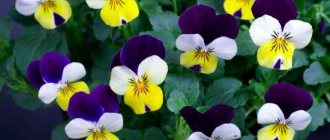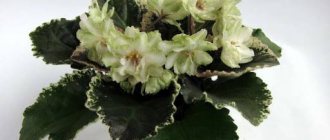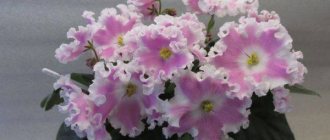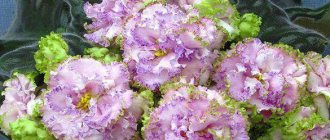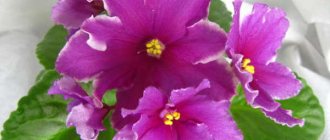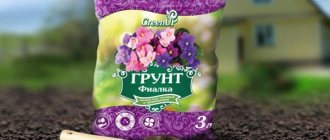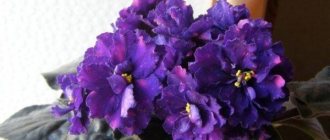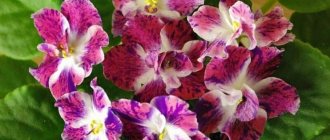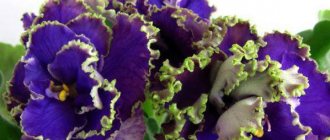Violet cuttings
This method is most often used at home. In this case, rooting occurs almost 100%. But when growing “Virgin Mary” violets, you should remember that this variety is highly athletic. Therefore, no one can guarantee that a flower grown from a leaf will have the same flowering characteristics as the mother plant.
- Carefully cut a strong leaf from a healthy mother plant at an angle.
- The leaves are rooted both in water and in soil or a peat tablet.
- The cut leaf should be rooted immediately.
- You can create greenhouse conditions for it using a glass.
- After some time, babies will appear on the cuttings. At this stage, you should carefully remove the leaf.
- Under favorable conditions, the violet will bloom in 1 year.
Properties
Name
- Original: Marquise
- Transcription:
- Translation:
Registration
- Selection: T. Dadoyan
- Year: 2010
Socket
- Socket type: standard
Flower
- Flower size, up to: 5.5 cm
- Flower shape: star
- Terry: terry
- Main Color: Hot Pink
- Color type: plain
- Border: double
- Other features:
Foliage
- foliage color: dark green
- foliage type: simple
- foliage shape: pointed, heart-shaped; quilted
- reverse side of sheet: red
- leaf edge: jagged edge
- variegation
Online store “PoTsvety”
Our store presents indoor flowers of different types and varieties from a private collection. From us you can purchase both adult flowering plants and planting material: leaf cuttings, children, tubers, etc. All plants are adapted to indoor conditions. Twice a year the entire collection undergoes comprehensive preventative pest control. The collection has been collected since 2010 and is constantly updated with new exclusive varieties of beautifully flowering indoor plants.
You can place an order in any way convenient for you: directly through the store by creating a basket; by phone 8-906-854-07-75 (WhatsApp, Viber); via email (in a message or text of the letter, write the names of plant varieties and specify in what form you would like to purchase them (baby, cuttings, tuber, etc.)
An invoice for payment is issued after the order has been processed and some details have been agreed upon with you.
After receiving your order using any of the above methods, we will contact you by phone or email.
The terms of delivery of the order are negotiated separately; you can express all your wishes in the comments to the order.
Violet Maria (T. Dadoyan)
Tender violet Maria (T. Dadoyan).
The species that loves mountainous Africa, “violet” (or Saintpaulia), contains both annual and perennial plants . It belongs to the Gesneriaceae family. The flower has enjoyed enormous unabating popularity all over the world for many decades. The species is valuable not only for the diverse beauty of its varieties, but also for its rather unpretentious maintenance requirements.
The main thing is to know the basics of care , and sincerely admire your specimen - this way the plant will try its best to please the owner with exuberant flowering.
History of origin
Experienced and widely known breeder Tatyana Lvovna Dadoyan obtained Maria by sporting from the Fairy variety . The fairy, a double miracle, covered with large white flowers with a deep pink tint, became a good parent, passing on to Mary all her varietal beauty. This is how a luxurious fixed sport turned out.
The variety belongs to Tatyana Dadoyan.
Quote (T.L. Dadoyan): “The flowers are large, up to 7 cm. Densely double, they remain in the form of “heads of cabbage” for a long time during dissolution. The petals are white with a slight pinkish tint, along the edge there is a crimson border with a dusting and a thick green ruffle. The leaf is medium green, wavy.”
Maria has the same one as the Fairy:
- Fluffy corrugated edge frill of petals;
- And the delightful shape of the flowers, reminiscent of a delicate rose enclosed in a head of cabbage.
Distinctive features
- Densely double large flowers (5 – 7 cm);
- The petals are white with a pinkish tint, the border is from fuchse to bright crimson, ending in a light green thick ruffle;
- The brightness of the color is determined by temperature and lighting;
- Flowering is exceptionally long;
- The leaves are standard, lush green, with a light wavy edge and curly at the rosette;
- Loose, voluminous rosette;
- The petioles are long.
The plant develops slowly; before flowering it needs to become sufficiently strong , but this feature is more than compensated for by its unpretentiousness and abundance of children.
Advice! A real varietal plant will “overgrow” with a light green ruffle in any case, but to be sure, you should wait for at least the third flowering.
Georgia Dadoyan violet photo
Uzambara violet.
Family Gesneriaceae - Gesneriaceae.
Genus Saintpaulia hybrida - Hybrid Saintpaulia.
African violet saintpaulia hybrid.
Violets from breeders of the CIS countries - “D”.
Georgia (T. Dadoyan).
The flowers are very large, double, bright pink with a crimson-coated border, the edges of which are decorated with a thick, ruffled green ruffle.
Varietal rosette with straight leaves. Foliage grows very little, elongated petioles. The leaves age and turn yellow very quickly. The rosette is large, sloppy, problematic, and twists the leaves.
When blooming, the color is pale pink, but after a couple of days it becomes deep pink, then lightens slightly. The width and saturation of the border, as well as the brightness of the main color, varies depending on age and time of year. In cool conditions the flowers develop a nice greenish ruffle.
Different peduncles of the same rosette can produce flowers of different color intensity. The first flower on the peduncle is the largest - up to 6 cm, the rest are slightly smaller.
From one leaf you get both wavy children and those with straight leaves. It grows very slowly. It is necessary to remove the flower stalks several times in a row, then the leaf mass begins to grow. The socket got better after I switched it to the wick. A sport with curly leaves, a very ugly rosette.
Georgia is a state in the southeastern United States. The capital and largest city is Atlanta. Georgia's official nicknames are the “Peach State” and the “Imperial State of the South.”
Before the Spanish colonization of America, there was an Indian culture in Georgia that completely disappeared by 1560.
Do you know that…?
Pink varieties. This category includes all shades of pink, from delicate to rich, almost raspberry. Pink is one of the most difficult colors.
There are many shades of pink: hot pink, hot carmine pink, dark pink, light pink, bright peach, mauve, soft pink purple, warm, cool, muted, beige pink and taupe pink. -raspberry and pink-coral. Any pink is always a complex mixture of several tones.
Before you buy the violets listed below, carefully read the forums about their behavior on the windowsill. Many of them are very beautiful flowers.
Are they suitable for your window sill and the conditions that you can create for them? You will look at the flowers for several months, and the rosette will always be in front of your eyes.
There are many beautiful flowers, there are much fewer beautiful and neat rosettes, look first at the rosette! Search and you may find a dozen violets with the same flower color if you are not interested in the smallest details as a collector.
• — Wedding Day (Lazarenko); • — Day by Day (Arkhipov); • — Curiosity (Morev); • — Brownie Kuzya (Burkatsky); • - Dulcinea (Prilutskaya);
Violet, thanks to its beauty and variety of varieties, has won the love of many plant growers. It does not require much attention to itself, but will delight you with large and beautiful flowers if you fertilize it on time and give it the necessary amount of light and moisture.
Description of the variety
Violet "Georgia" from breeder T. Dadoyan has pink, large double flowers. Along the edge they are decorated with a yellow-green border and a crimson coating. The border can be thick or thin, depending on the time of year.
The intensity of the color of the flowers also changes. The first flowers are the largest, they reach a diameter of 6 centimeters, the subsequent ones are smaller. There are many flower stalks, and when the buds bloom, they fall under the weight.
In order for the leaf mass to grow, it is necessary to remove flower stalks more often. There is not a lot of foliage on the bush; it is all straight, quickly dies and loses its attractiveness, and therefore requires timely pruning.
The rosette turns out to be sloppy, so the foliage often curls.
Indoor conditions
In general, violets are able to adapt to different indoor conditions, but sometimes they can be capricious and not bloom.
It is best to maintain the inside temperature between 21 and 23 degrees during the day and at night at least 15 degrees. These are plants that prefer high humidity in their environment.
It is especially important to take care of this in winter, when the heating is on in the room and the air becomes completely dry.
Growing
As we have already said, this plant is quite unpretentious, but you should pay attention to the following tips before planting it:
- the pot should be of medium size, since the plant will dynamically grow its root system, so a container that is too small will lead to the death of the violet;
- It is better to place “Maria” on the western or “eastern side; the lighting should completely “envelop” the plant, so do not forget to turn it periodically;
- It’s a good idea to purchase artificial lighting (fluorescent lamps are suitable);
- the optimal air temperature for violets is up to 22 degrees above zero;
- this variety does not welcome constant drafts and direct sunlight;
- use a special soil for Saintpaulia or a mixture (it contains leaf, coniferous and peat soils with the addition of baking powder).
Home care
The most comfortable place to keep violets are considered to be windows that overlook:
- Southeast;
- Or the southwest side.
This is due to the fact that Saintpaulias do not like bright light, and exposure to direct sunlight is detrimental to them. Moreover, if you keep plants in the area described above, they will actively grow and develop without experiencing discomfort from a lack or excess of lighting.
In addition to observing the light regime for Saintpaulias, the following are also very important:
- Proper watering;
- And periodic feeding;
- Ambient air temperature and humidity.
In addition, to maintain it at home, the gardener must be able to carry out hygiene procedures and pruning the plant in order to rejuvenate it.
Proper watering and fertilizing
It is necessary to water the flower:
- At least 1-2 times a week in spring and summer;
- And at least 3-4 times a month - during the cold season.
CAREFULLY! More frequent watering can lead to rotting of the root system, which will lead to the death of the plant. In turn, rare, irregular watering at any time interval can lead to drying out of the soil, lack of nutrients, and, as a result, death of the flower. Violets need to be watered 2 times a week
Violets need to be watered 2 times a week.
Also, for better flower development, it is recommended to alternate simple watering with watering with liquid fertilizer. To apply this type of fertilizing, it is enough to dissolve 1 cap of concentrate in 1 liter of water, after which you can water it.
Thus, during the hot season there should be at least 3-4 feedings, while in winter and autumn their number naturally decreases to 1-2 per month.
Lighting and temperature
For violets, an air temperature of no higher than 18-20 degrees Celsius is considered acceptable. If Saintpaulias stop blooming, you can create artificial shock conditions for them by placing them on the balcony for several hours.
Thus, the air temperature will drop to 16-18 degrees, which will contribute to the resumption of flowering of the variety.
This procedure is allowed to be repeated no more than 1-2 times every six months, and this should be done exclusively during the warm season. Violation of these instructions can be fraught with the life of the flower and its development.
They don't like Saintpaulia:
- Bright light;
- And direct sunlight.
But despite this, some gardeners still recommend allowing their green favorites bright light in the morning (from dawn to 10 a.m., and from 4 p.m. to sunset), during those time periods when the sun’s rays cannot harm the plant.
Effect of air humidity
Despite the fact that the tropics are considered the homeland of violets, excessively humid air is harmful to them.
The maximum permissible air humidity is considered to be no higher than 60%. Otherwise, this is fraught with rotting of the plant’s root system.
If you need to increase the percentage of humidity at home, you can use trays with water, which are placed around the entire perimeter of the room.
What kind of soil does he prefer?
When growing Saintpaulias at home, you can use purchased soil for Saintpaulias, or prepare it yourself. For such soil you will need:
- Chernozem;
- Sand;
- Tree moss (sphagnum)
- Drainage.
Mix all ingredients in equal proportions.
Soil for violets can be bought at a flower shop.
Pruning and hygiene
In order for violets to develop correctly and fully, they need to be provided with:
- Not just care;
- But also decent hygiene.
Plants should be promptly removed from dry leaves and buds that have bloomed, as well as:
- Trim dry branches;
- Multiply;
- And replant the plant.
ADVICE! When propagating a plant by cuttings or leaves, it is best to powder the cut site with crushed activated carbon or ground cinnamon. This eliminates the possibility of plant infection.
Reproduction methods
There are three main ways to propagate violets:
- Handle;
- Leaf;
- Stepson.
For chimeras and sports, leaf propagation is most suitable, since with this method the generic characteristics of the flower are preserved.
Violets "Maria": description of the variety and rules of care
Every housewife knows that it is impossible to create comfort in a home without decorative flowers. One of the most popular indoor plants is the violet. Its varieties are so diverse that sometimes it is even difficult to make a choice. The violet with the beautiful female name “Maria” is very popular among Russian flower growers.
Amazing star-shaped flowers look simply stunning in any interior.
Violet - the queen of window sills
There are a large number of varieties of violets, which differ from each other in the shape of the flower and leaves. This variety allows you to choose the most suitable variety that will fit perfectly into the interior of the room. But experienced flower growers know that the Maria violet is suitable for everyone.
All gardeners dream of growing violets. This plant is unpretentious, and after a short time it will delight you with long, abundant flowering.
History of the violet
Violet is an annual or perennial plant. The flower belongs to the Gesneriaceae family. In nature, this flower prefers to grow in the mountainous regions of Africa. This plant is widespread throughout the globe. The minimum requirements for growing conditions are what the indoor violet “Maria” is valued for. The main thing is to create optimal conditions for growth.
They began to grow violets as a houseplant only in the 20th century. During this time, breeders have created many species that delight the eye with their appearance.
But T. Dadoyan gave flower lovers an unforgettable variety of violet “Maria”. The flower is characterized by large, densely double corollas. This variety can truly be called a highlight. The breeders tried to combine all the best in it: a corrugated frill along the edge of the petals, a fantasy pattern of amazing shape. The flower itself resembles a small rose. Maria violet is a luxurious variety with a bright green rosette and attractive pink flowers.
Reproduction
Like other varieties of violets, the violet variety Maria Dadoyan can be propagated in several ways: rooting cuttings, sowing seeds and pinching. In the case of violets, the seed propagation method is practically not used; it is more suitable for breeding new varieties, but cuttings and pinching are quite simple methods that even a novice florist can handle.
- In the first case, you will need a leaf cutting (in other words, a violet leaf). Choose a healthy and large leaf with a long petiole, cut it with a sharp knife or scissors (you must first disinfect the tool). Then the leaf should be placed in a container of water or deepened into moist soil a couple of centimeters. Roots appear quite quickly, but “babies” or daughter rosettes form only after a couple of months.
- When pinching, the daughter rosette is separated from the adult mother plant also using a sharp sterile instrument (the cut site can be sprinkled with crushed charcoal or activated carbon). It is necessary to separate a rosette that has two or three leaves, but it is very important not to damage the mother plant. Then build a mini greenhouse and root the rosette in it (with regular soil moisture and ventilation) for 1-1.5 months. As soon as new leaves begin to grow, rooting can be considered successful, then the plant should be replanted and the Maria violet should be cared for as an adult plant.
How to care
Proper watering is very important for “Maria”. Experts recommend watering a houseplant no more than 2 times a week. Two methods of watering are suitable: top and bottom. The first is characterized by filling the violet pot with water “to the brim”, but the leaves are not properly moistened. The bottom method involves filling the pot tray with water.
The liquid for irrigation should be warm. It is not recommended to water violets with ice water. Air humidity in the room is not lower than 50%. You can periodically carefully spray the plant with a spray bottle. During the flowering period, violets need fertilizing with mineral fertilizers (at least 2 times a week).
top watering
wick irrigation
In winter, the gentle “Maria” needs a more reverent attitude. Artificial lighting will help you (its duration should be up to 13 hours a day). It is also better to reduce watering from December to March.
Photo
Marquise, T. Dadoyan, photo by T. Lysikova (first flowering):
The most popular varieties
Dadoyan worked with violets for about 5 years and during this time there are no more than 20 varieties of her selection. The most commonly heard varieties are:
- Georgia - violet flowers are large, double, bright pink in color with a crimson border-spray, the edges of the border are decorated with a thick, corrugated green ruffle. Strong peduncles, curly basal rosette. The leaves are regular, slightly pubescent. Georgia contains a lot of buds on the bush, the flowering period is short.
- Maria is a beautiful curly sport from the Fairy variety. It has large, heavily double pink flowers with a raspberry coating and a green ruffle along the pom-pom flower.
- Aquatic - flowers are bright deep blue, double, with streaks or lightened fragments along the edges of the petals of a pinkish tint. Along the edge of the petals there is a green ruffled border. The leaves are dark, quilted with a slightly wavy edge. Sometimes the leaves have red spots on the white backside. The violet grows quickly, the buds blooming very slowly, but simultaneously.
- Snow White - the flowers of the plant are large, in the form of fluffy terry balls of pure white color with wavy edges of the petals. The leaves of the violet are glossy, wavy, bright green. The plant stands out for its abundant bouquet flowering.
- Grinya - flowers are large, fluffy, semi-double and double, white with a thick corrugated green ruffle along the edge of the petals. The leaves are regular, lanceolate, slightly pubescent. It blooms with a magnificent bouquet, abundant flowering.
- Droplet is a plant with large, semi-double, white flowers with wavy edges of the petals. Each flower has a distinct purple eye in the center of the bud. The leaves are elongated, light green in color. The rosette is neat at the root. The plant blooms quickly, blooms profusely and for a long time.
- Wild cherry - the flowers of the plant are large, semi-double, bright cherry color with a clear, wide white border. Externally, the flower can be compared to a multi-pointed three-dimensional star. The leaves are dark green, spoon-shaped, lanceolate. Wild cherry is a sport from the Frosty Cherry variety.
- Running on the waves - the flowers are huge, double, variable white with dark blue fragments interspersed. The leaves are regular, dark green. The rosette is neat at the root. The plant blooms quickly, blooms profusely and for a long time.
- The poet Yuri Gal is a soft pink, “porcelain” violet; it got its name in honor of the poet Gal, whose prisoner Tatyana’s father once saved in Stalin’s camps. Then Dadoyan had one goal - to save, survive and joy will come. This plant is capricious; if not properly cared for, it quickly dies, but its goal is also to survive and give joy.
Distinctive features
Tatyana Dadoyan is working on the discovery of new species of Uzambara violets. The flowers of the breeder Dadoyan have a number of distinctive features:
- In almost all varieties, the shape of the leaves is regular, spoon-shaped, the leaf edges are smooth (less often jagged or wavy);
- leaves are lanceolate, glossy with slight pubescence;
- Dadoyan violets love a lot of light;
- all flowers in all varieties are in the form of terry pompoms;
- the leaves of all varieties of Uzambara violets emerge from one point, all of them are collected in a basal rosette;
- The flowering of violets is abundant and long, the majority of varieties are characterized by slow opening of buds;
- Violets bloom in a bouquet, each flower has its own separate miniature pubescent peduncle.
We invite all connoisseurs of the beauty of this flower to familiarize themselves with other types of violets. We described in detail the following varieties: the chic varieties of the Optimara series, the charming Frosty and Winter Cherries, the unpretentious Greenhouse Effect, the prolific and not capricious Isadora, the original Chanson, the amazing Bronze Horseman, the beautiful Blue Fog, as well as interesting varieties bred by breeders K. Morev and E Arkhipov.
